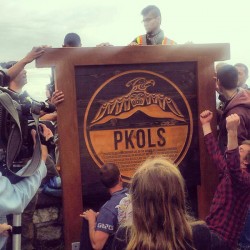Article Origin
Volume
Issue
Year
The name of Vancouver Island’s Saanich nation – WSÁNEC, as they spell it – means “emerging people.” And today, a remarkable re-emergence of traditional names is occurring in the peninsula they call home.
More than 10,000 years ago, explained elder WEC’KINEM (Eric Pelkey), the Creator warned inhabitants of an impending Great Flood, but only a handful heeded his warning: Build giant canoes and tether them with long cedar ropes to the arbutus tree atop the highest mountain in the land, LÁU,WELNEW.
The flood waters rose and receded. Those in the canoe were the only survivors, emerging to become the WSÁNEC, or emerging, people. LÁU,WELNEW mountain became a sacred site, but when Europeans arrived it was christened Mount Newton after a Hudsons Bay Company surveyor.
Today, the mountain remains one of the most revered places for the Indigenous peoples in the area, central to their history, spirituality and survival.
“That is the place our people survived the Great Flood,” WEC’KINEM told Windspeaker. “It’s a sacred mountain ... right in the middle of all our communities of the WSÁNEC nation.”
This autumn, WEC’KINEM and other Elders plan to formally restore the mountain its ancient title. The plans follow a dramatic re-naming ceremony on May 22 at the summit of another important landmark, further south in their territory.
In what is predicted to be just the first of a string of traditional naming events, more than 600 people reclaimed the traditional name of Mount Douglas–PKOLS, or “white rock” – by praying and planting a sturdy wooden sign carved by renowned local artist Charles Elliott.
The participants also re-enacted the 1852 signing of a treaty with Governor and Hudson’s Bay Company official James Douglas on that very mountaintop, remembering one of only 14 historic agreements with First Nations in a province that remains largely unceded.
But like many treaties today, the Douglas Treaty was never upheld.
“When Sir James Douglas brought us into treaty, it was primarily supposed to be a peace treaty between our nations,” WEC’KINEM said. “Nation-to-nation.
“It wasn’t honoured, and as far as we’re concerned we’re still living with the effects of that treaty, alienation from our lands, the loss of our village sites, and still persecuted for carrying our Aboriginal rights like hunting and fishing.”
The May 22 ceremony also attracted local authorities, politicians and police, who stood by as Elliot’s hefty thunderbird sign was sunk into cement-filled holes. The event and sign-raising were held without authorization or permit, a fact that author Taiaiake Alfred, with the Indigenous Nationhood Movement, argues is significant for Indigenous rights.
“We did not ask permission,” Alfred, an Indigenous Governance professor at the University of Victoria, told Windspeaker. “One of the biggest problems in Canadian politics is we’re always asking for permission.
“The agenda of Idle No More is to ask permission or to demand something from the government, when in fact I think the strongest move you can make is just to act Indigenous, and to act on your teachings... In fact, I think the authorities respected how well-organized we were.”
The Mohawk author of Was·se: Indigenous Pathways of Action and Freedom (2005) added that the movement to rename PKOLS was a “coming together of forces,” drawing together WSÁNEC leadership and elders with non-Indigenous allies and other nations’ supporters like himself.
“Our group, the Indigenous Nationhood Movement, felt it was time to go beyond the agenda we all had in Idle No More, to actually reasserting ourselves on the land,” he explained. “I saw the pride in the young kids; I saw the leadership coming together.
“I saw all kinds of goodness and power manifested on that mountain. I was really happy to be a part of it, and see this movement go forward.”
Only after the PKOLS sign was planted and a ceremony held did organizers apply for an official government renaming, WEC’KINEM told Windspeaker.
“We request that the province of B.C. officially recognize the traditional name PKOLS to replace the colonial name Mount Douglas in the Geographic Names Registry,” he wrote in a letter to the province’s Geographical Names Office. The office would not comment on the application.
But for organizers, it was their traditional naming ceremony, not any official recognition, which was most significant. The fact that elected officials and police alike expressed support was simply confirmation of broader community backing. WEC’KINEM heard from local politicians that the sign “really adds to the history of the area,” he said.
“I was happy to see so many young people there,” he added. “It really warmed my heart.
“We led the way, but we couldn’t have done it without the support of (the people of) the greater Victoria area who wanted to help... It was a great effort by the community, not only the WSÁNEC tribe.”
PKOLS is not the first act of renaming in B.C. In 2010, the province officially recognized the “Salish Sea” to denote the straits of Juan de Fuca and Georgia, while also retaining their colonial names. Likewise, in 2009 the Queen Charlotte Islands were restored to Haida Gwaii.
Alfred hopes the resurgence of Indigenous names will reverberate far beyond southern Vancouver Island and B.C.
“All important landmarks need to be reclaimed in this way,” he said. “They represent essential elements of the Indigenous spiritual universe. To have them named after biologists or colonial figures that mean nothing to this land is an injustice.”
Recalling a number of different Aboriginal nationalities who congratulated him at the May 22 ceremony, WEC’KINEM agreed.
“I would support anybody else who wants to lead direct action to protect their territories,” he mused.
- 3317 views

